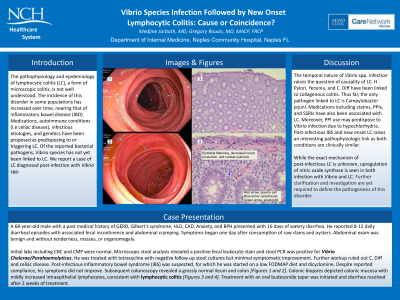Back


Poster Session D - Tuesday Morning
Category: Colon
D0140 - Vibrio Species Infection Followed by New Onset Lymphocytic Colitis: Cause or Coincidence?
Tuesday, October 25, 2022
10:00 AM – 12:00 PM ET
Location: Crown Ballroom

Has Audio

Medjine Jarbath, MD
NCH Healthcare System
Naples, FL
Presenting Author(s)
Medjine Jarbath, MD1, Gregory Rouan, MD2
1NCH Healthcare System, Naples, FL; 2University of Cincinnati College of Medicine, Cincinnati, OH
Introduction:
The pathophysiology and epidemiology of lymphocytic colitis (LC), a form of microscopic colitis, is not well understood. The incidence of this disorder in some populations has increased over time, nearing that of inflammatory bowel disease (IBD). Medications, autoimmune conditions, infectious etiologies, and genetics have been proposed as predisposing to or triggering LC. Of the reported bacterial pathogens, Vibrio species has not yet been linked to LC. We report a case of LC diagnosed post-infection with Vibrio spp.
Case Description/Methods: A 68-year-old male with a past medical history of Gilbert syndrome, remote tobacco use, GERD, anxiety and hyperlipidemia presented with 8-12 episodes daily of watery diarrhea for 16 days. The diarrhea, associated with fecal incontinence and abdominal cramping, began after consumption of raw clams and oysters. The patient’s abdominal exam was without tenderness to palpation, masses, or organomegaly. Initial labs showed no leukocytosis and electrolytes were normal. Stool studies demonstrated a positive fecal leukocyte stain. A stool PCR was positive for Vibrio cholerae/parahaemolyticus. He was treated with tetracycline, though his symptoms did not completely relent. Repeat stool cultures were negative despite residual loose stools. Further workup included a negative stool C. Diff toxin and excluded celiac disease. Postinfectious IBD was suspected, and he was started on a FODMAP diet and dicyclomine. Despite reported compliance, his symptoms did not improve. Subsequent colonoscopy revealed a grossly normal ileum and colon. Colonic biopsies depicted colonic mucosa with mildly increased intraepithelial lymphocytes, consistent with LC. Treatment was initiated with oral budesonide and tapered. Diarrhea resolved after 2 weeks of treatment.
Discussion: The temporal nature of Vibrio spp. infection raises the question of causality of LC. H. Pylori, Yersinia, and C. Diff have been linked to collagenous colitis. Thus far, LC has only been linked to Campylobacter jejuni. Statins, PPIs, and SSRIs have also been associated with LC. PPI use may predispose to Vibrio infection due to hypochlorhydria. Consideration of post-infectious IBD and new onset LC raises an interesting point, as the conditions are clinically similar. While the exact mechanism of post-infectious LC is unknown, upregulation of nitric oxide synthase is seen in both infection with Vibrio and LC. Further metabolic clarification and investigation are yet required to define the pathogenesis of this disorder.
Disclosures:
Medjine Jarbath, MD1, Gregory Rouan, MD2. D0140 - Vibrio Species Infection Followed by New Onset Lymphocytic Colitis: Cause or Coincidence?, ACG 2022 Annual Scientific Meeting Abstracts. Charlotte, NC: American College of Gastroenterology.
1NCH Healthcare System, Naples, FL; 2University of Cincinnati College of Medicine, Cincinnati, OH
Introduction:
The pathophysiology and epidemiology of lymphocytic colitis (LC), a form of microscopic colitis, is not well understood. The incidence of this disorder in some populations has increased over time, nearing that of inflammatory bowel disease (IBD). Medications, autoimmune conditions, infectious etiologies, and genetics have been proposed as predisposing to or triggering LC. Of the reported bacterial pathogens, Vibrio species has not yet been linked to LC. We report a case of LC diagnosed post-infection with Vibrio spp.
Case Description/Methods: A 68-year-old male with a past medical history of Gilbert syndrome, remote tobacco use, GERD, anxiety and hyperlipidemia presented with 8-12 episodes daily of watery diarrhea for 16 days. The diarrhea, associated with fecal incontinence and abdominal cramping, began after consumption of raw clams and oysters. The patient’s abdominal exam was without tenderness to palpation, masses, or organomegaly. Initial labs showed no leukocytosis and electrolytes were normal. Stool studies demonstrated a positive fecal leukocyte stain. A stool PCR was positive for Vibrio cholerae/parahaemolyticus. He was treated with tetracycline, though his symptoms did not completely relent. Repeat stool cultures were negative despite residual loose stools. Further workup included a negative stool C. Diff toxin and excluded celiac disease. Postinfectious IBD was suspected, and he was started on a FODMAP diet and dicyclomine. Despite reported compliance, his symptoms did not improve. Subsequent colonoscopy revealed a grossly normal ileum and colon. Colonic biopsies depicted colonic mucosa with mildly increased intraepithelial lymphocytes, consistent with LC. Treatment was initiated with oral budesonide and tapered. Diarrhea resolved after 2 weeks of treatment.
Discussion: The temporal nature of Vibrio spp. infection raises the question of causality of LC. H. Pylori, Yersinia, and C. Diff have been linked to collagenous colitis. Thus far, LC has only been linked to Campylobacter jejuni. Statins, PPIs, and SSRIs have also been associated with LC. PPI use may predispose to Vibrio infection due to hypochlorhydria. Consideration of post-infectious IBD and new onset LC raises an interesting point, as the conditions are clinically similar. While the exact mechanism of post-infectious LC is unknown, upregulation of nitric oxide synthase is seen in both infection with Vibrio and LC. Further metabolic clarification and investigation are yet required to define the pathogenesis of this disorder.
Disclosures:
Medjine Jarbath indicated no relevant financial relationships.
Gregory Rouan indicated no relevant financial relationships.
Medjine Jarbath, MD1, Gregory Rouan, MD2. D0140 - Vibrio Species Infection Followed by New Onset Lymphocytic Colitis: Cause or Coincidence?, ACG 2022 Annual Scientific Meeting Abstracts. Charlotte, NC: American College of Gastroenterology.

